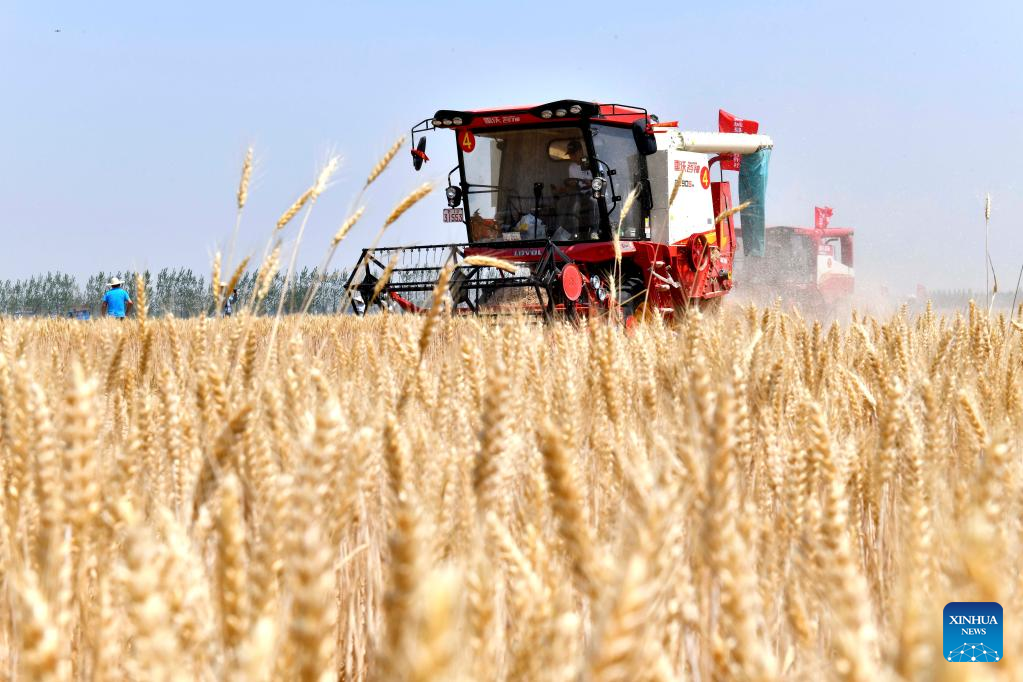China takes action to reduce grain loss rate at reaping, storing and processing stages of production
Recently, the summer harvest has come into full swing across China. Various localities are doing their best to lower the loss rates for this year’s wheat and rice harvest.

Harvesters reap wheat in the field in Tancheng County of Linyi City, east China's Shandong Province, June 2, 2022. Shandong, one of the country's major wheat production base, has ushered in its harvest season in this summer at present. (Xinhua/Guo Xulei)
In a high-quality rice field in Tangshi village, Xingguo county, east China’s Jiangxi Province, ears of early-season rice were sprouting.
“In the past, because we harvested rice using the traditional method, the loss of grain was inevitable,” said Zhong Xianhua, owner of the rice field. Six years ago, Zhong bought his first harvester. With the support of subsidies for farm machinery purchases, the man has bought several harvesters over the past years, and each of the machines has been able to outperform their predecessors, helping the man reduce harvest losses significantly.
The loss rate for grain harvested by machines can be kept between 3 and 5 percent, which is much lower than that for manual harvesting at around 10 percent, introduced Liu Xiaowei, an official with the Department of Agricultural Mechanization of the Ministry of Agriculture and Rural Affairs (MARA).
Liu introduced that at present, 97 percent of the country’s wheat, 94 percent of its rice, and 78 percent of its corn has been harvested using machines.
Xie Jianping, secretary of the Party branch of Tangshi village, said rice grown on over 2,000 mu (133.33 hectares) of fields in the village has been harvested using machines, and the grain loss rate has constantly been lowered.
Huaxian county is a major wheat production base in the northern part of central China’s Henan Province. Du Huanyong, head of an agricultural cooperative in Wangu township, Huaxian county, introduced that this year, the BeiDou Navigation Satellite System (BDS) has been applied to facilitate precise seeding, which significantly cut down the costs associated with ploughing.
During the summer harvest last year, the MARA organized skills competitions for harvester operators to showcase their skills in reducing grain losses in eight major wheat production provinces, which helped reduce 1.5 billion kilograms of wheat losses in the Huang-Huai-Hai region.
This year, Li Xiaogen, a farmer in Huaining county, east China’s Anhui Province, has planted rice on 634 mu (42.27 hectares) of farmland, more than he did last year. The reason why he feels assured to expand the rice planting area is because a grain drying factory has been built near his home. “A grain dryer can dry more than 120 metric tonnes of rice grains in one day,” said Li.
Huaining county is a major grain production base in Anhui Province, where the total rice planting area stands at more than 500,000 mu each year. In the past, farmers dried rice grains on the roadways, which not only affected traffic, but also caused grain losses, Li said.
Nowadays, the county has improved post-production services, and encouraged large grain growers and agricultural cooperatives to buy grain driers and then provide drying services for farmers living nearby, helping local farmers solve the problems they encounter in the drying and storing of grains.
Strengthening the grain processing stage is also an important way to reduce grain losses and protect food safety. Wang Fengzhong, director of the research institute on agro-products processing with the Chinese Academy of Agricultural Sciences, said that according to an estimate, the loss rate of wheat and grain processing has been kept between 4 percent and 5 percent in China.
Recently, the MARA issued a notification to promote 24 typical cases in the extensive processing of grains. In these cases, the grain loss rate was lowered to below 2 percent by improving the processing technologies and by upgrading the processing equipment used.
Photos
Related Stories
- Blueberries enter harvest season in China's Guizhou
- Wheat straw harvest in Central China
- China has reaped over 80 pct of wheat
- Northwest China's Baoji begins sowing of autumn grain after summer harvest
- Consecutive bumper harvests ensure China's grain security
- Pic story: couple busy with wheat harvest in north China
- Wheat harvested in Xisong, Hebei
- China reaps bumper summer harvest securing food security
- Shift towards greater mechanization helps facilitate efficiency improvements in summer harvest across China
- Unique landscape: Good harvest in sight in Beijing's experimental field
Copyright © 2022 People's Daily Online. All Rights Reserved.









